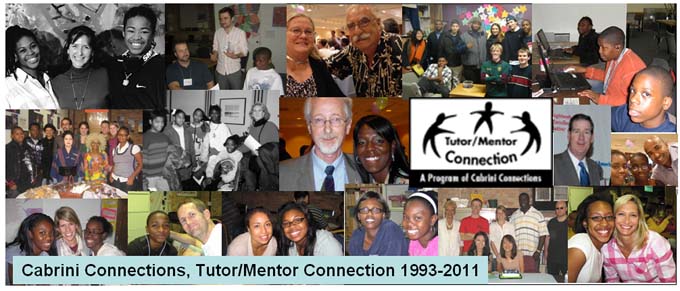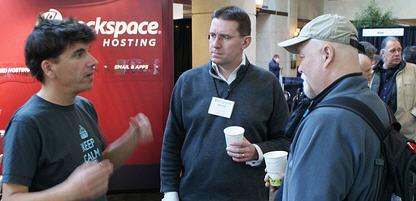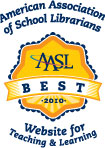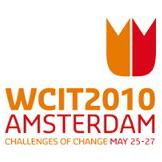Category: Visualisation
The Future of Digital Publishing?
Last month’s news that NBC News is launching its first eBook publishing division, may have raised a smile of recognition from Paul Peacock, an ePublishing industry pioneer who announced his ebook publishing company in The New York Times Book Review in June 1991.
Paul, a Debategraph Associate in New York, views Debategraph as an exemplar of a new and powerful form of electronic publishing that he calls dynamic information graphs (or “difographs”); a concept that he explores in the guest post, and embedded graph, below.
Future A for digital publishing (where the word “publishing” is used, loosely, to describe the process whereby “books” are made available to the public) is to take “books” and put them into electronic containers. But they remain siloed collections of information.
With websites and blogs we are able to use hypertext “links” to jump between two-dimensional knowledge collections (between “pages” on the same site or between sites). We are not able to show anything about the relationship between these collections or explicitly show information associated with the links (although the Google algorithm could presumably tell us a lot).
This is a half-step away from Future A but still leaves us swimming in the information flow as we try to make sense of it.
A difograph or dynamic information graph is a hub-and-spoke system of information presentation laid out in space with information encoded into the “spokes” (links) that join hubs together. It can exist in two or three dimensions. Information of all kinds and types can be attached to a particular hub (in a “panel”). The difograph gives us a net to drag through the river of information so that we, standing now on the bank, can more easily understand what we are looking at. Furthermore, difographs produced by different publishing entities can be linked together, creating seamless larger networks.
Difograph publishing is the Future B of digital publishing. The “hub” is its fundamental element in the way the “book” is for the print publishing industry.
A “view” is a presentation frame centered on a particular element of a difograph. The embedded view above can be embedded on your website by clicking on the Embed link in the top navigation bar (when you are in the Display mode you prefer) to get the appropriate code. It will update automatically as changes are made to it. debategraph.org/difographe is a short web address for the graph.
Mapping the Political Contours of Cyberspace
William Gibson coined the term “cyberspace”, for his 1982 short story Burning Chrome to create a “a narrative engine, and a territory in which the narrative could take place”. Twenty years on, cyberspace is the world’s narrative engine: and an uncharted territory to which the world is still coming to terms.
Political, industrial, and civic leaders are gathering at the Foreign Office’s London Conference on Cyberspace next week to think through the implications, opportunities and contradictions of this emerging world.
The conference will explore key themes – prosperity; social good; freedom of access and expression; cyber crime and international security – with the aim of deepening mutual understanding and beginning to outline a political, social and economic strategy to secure the benefits of cyberspace while addressing the concomitant threats to personal and national security.
The Foreign Office would like the dialogue at the event and online to be as broad as possible – and, in support of this process, Debategraph will be mapping and curating the dialogue as it unfolds live and online.
To start exploring the map – which we have seeded with the initial framework of the conference – click on the small bubbles to move deeper into the debate and on the larger bubbles to move back up.
You can gain an insight into the range and scope of the debate by watching the map evolve here, but you are welcome to add your voice to the debate online by adding new ideas and comments to the map and by rating the ideas, or by suggesting new ideas and questions via Twitter using the #LondonCyber hashtag and/or the Foreign Secretary’s Facebook channel (both of which we will be monitoring as well).
As discussed before, the whole structure of the map is like a wiki – every aspect is provisional, and open to further refinement – and everyone can add new issues, positions, arguments and evidence to the map.
The aim is to weave together all of the arguments into a rich, transparent, non-linear structure that anyone can explore and understand quickly.
As with the other maps in the The Independent series you can keep up to date with developments via @TheIndyDebate on Twitter, and you are welcome to embed the map (like a YouTube video) on your own site or blog using the code shown below:
*Cross-posted at: The Independent
Helping Kids in Poverty Find Work
Debategraph connected recently with Dan Bassill, founder and president of the Tutor/Mentor Institute LLC and the Tutor/Mentor Connection.
Dan has been working with inner-city youth in Chicago for more than 36 years and also had a 17 year career in corporate advertising with the historic Montgomery Ward Corporation.
Drawing on his advertising experience, Dan began to address the challenge of helping kids in poverty from a business innovation and marketing perspective, rather than social work or youth education perspective.
In the guest blog below, Dan reflects on some of the lessons learned and challenges ahead, and invites you add your voice to the conversation on the Helping kids born in poverty start jobs and careers Debategraph:
I believe that there are four concurrent strategies that could be applied in every major city in the world as part of a set of collective on-going actions to help reduce the costs of poverty in each city.
(1) Knowledge aggregation and visualization: The Tutor/Mentor Institute has been collecting information since 1993, showing where volunteer-based tutor/mentor programs are needed, why they are needed, what different programs do, and why business, philanthropy and others should support the growth of such programs as a strategy for expanding social capital surrounding youth in high poverty neighborhoods of large cities like Chicago, New York, and London. Aggregating and sharing the accumulated knowledge and insights can help the whole community to make faster and more effective progress – and save people from having to “reinvent the wheel” each time a new initiative starts. Using interactive sites like Debategraph, new ideas can be added to the library on an on-going basis, and embedded on the websites of any stakeholder organization around the world – allowing others to discover and build on innovative local solutions to poverty, poorly performing schools, drop out programs and workforce development that have already been implemented elsewhere.
The Tutor/Mentor Institute has also been experimenting with interactive geographical maps that can be used to locate tutor/mentor programs in specific parts of Chicago, and to determine the level of program availability in all parts of the city; making it easy for parents, volunteers and donors, as well as corporate leaders, city planners, marketers and policy makers to connect with the programs.
(2) Increasing public awareness: getting information is just the first challenge, getting millions of people to look at this information and use it in their own actions, is a bigger challenge. While I was working at Montgomery Ward our weekly ads drew shoppers to more than 400 stores, across 40 US states. Since no non-profit has the type of advertising budgets that large corporations have, we have to find creative and engaging ways to draw attention to tutoring/mentoring and the information hosted by the Tutor/Mentor Institute and others. One strategy for creating public awareness has been to organize events such as Tutor/Mentor Leadership and Networking Conferences, held every May and November since 1994. Such events draw 100-150 leaders and stakeholders together in Chicago but create much larger visibility during the months building up to the event. Forums like Debategraph enable the Tutor/Mentor Connection to connect its ideas to people in cities all over the world and to build on the contacts and dialogue between the conferences.
(3) Creating learning circles. Facilitating understanding: The amount of information is overwhelming. That’s an obstacle that can be overcome if volunteers are recruited to help others navigate and learn to use the resources of the library. The Tutor/Mentor Institute focuses on structured, volunteer-based tutor/mentor programs as a core part of its strategy because of the way such programs connect volunteers from the business community and who live beyond poverty with youth who do live in poverty. An organized tutor/mentor program can be a collective effort of many extra people working to help kids grow up. As volunteers stay with youth for one or more years many begin to bond and take on roles similar to “surrogate parents”. Such people become advocates and do much more to help the kids, and the tutor/mentor programs they are part of. Over time such people can become full-time advocates for expanded strategies to help poor kids to careers.
As we aggregate more and more information and increase the number of people who engage with the Tutor/Mentor Institute web sites, there also needs to be a process of facilitation, where people who know more about the information available in the knowledge base help others find and understand the information. In Chicago Interns have been writing blog articles and creating visualizations to help build understanding of this information. If you would be interested in volunteering as intern or discussion leader online, please let me know.

(4) Accelerating the flow of resources: The first three steps create a positive feedback loop as more people begin to use their time, talent and resources to support one or more tutor/mentor programs and, in turn, draw more people and resources into the movement in cities around the world. The information we share can be used by anyone, and the way we innovate public awareness strategies to motivate people to look at this information regularly, and to motivate people to act as volunteers and donors, can sustain this effort for many years into the future.
This not something that was created by the Mayor, the President or funded by a massive government or private foundation grant. The ideas in the Tutor/Mentor Institute were developed over a period of 35 years in response to what we learned as we struggled each year to find resources to operate one single small tutor/mentor program in Chicago. We have demonstrated the potential of the Internet, where people who “don’t have power, don’t have celebrity standing, and are not the elected leaders of a region can put their own ideas for building a better world on the Internet and invite others to join with them in making those ideas a reality.
It’s an idea in tune with our times: and if the idea of helping kids in poverty find work appeals to you, you are welcome to join us.
Controlling Persistent Infectious Diseases
The first in a quick series of posts to catch-up on some of our projects in 2011 so far.
At the start of March 2011 I was privileged to map a 5-Day workshop on “Modelling and analysis of options for controlling persistent infectious diseases” at the Banff International Research Station for Mathematical Discovery and Innovation; part of the breathtakingly beautiful Banff Centre in Alberta, Canada.


The workshop gathered 40 leading mathematical modellers, infectious disease researchers, clinicians and public health officials from around the world to explore the past and future contribution of the mathematical modelling to public health policy, the priorities for future research, and potential ways to enhance the relationship between the research community and public health officials.
Debategraph was used throughout the five-day workshop to the map the live discussions and to facilitate the group dialogue around the key points arising – with group members contributing directly to the map as the workshop proceeded.
The map resulting from the discussions – which the group is continuing to develop beyond the workshop – is embedded below:
Defrag 2010
Thanks to a Kauffman Foundation Entrepreneur Scholarship and Market Visit support from UKTI, I had the great pleasure of attending Defrag 2010 in Colorado last month and the opportunity to savour the vibrant start-up ecosystem in Boulder.
Defrag is organized brilliantly by Eric and Kim Norlin, with a perfect blend of attention to the detail that matters and a confident and playful informalty that cultivates a sense of community and serendipity. The upshot is a stimulating gathering on a human-scale, in which you find yourself marvelling at scintillating speakers in one moment and engaged in an impromtu seminar with them in the next:
I took the opportunity to map parts of the conference live as well, with the map shown below. The result is more of a dynamic scrapbook than a comprehensive map (with the latter requiring several mappers to cover the parallel sessions and, ideally, collaborative curation from the conference commuity as well). However, the map gives a flavour of the way in which graphs of this kind can be used to connect and distill the conference community, ideas and conversation from one conference to the next.
The graph also includes the slides from the presentations that have been made available online to date.
I travelled to Defrag with high expecations: and those expecations were exceeded by far; so, if you have the chance to attend Defrag 2011, seize the moment…
…and, if you can’t wait to sample the fun: Blur and Glue beckon too.
Debategraph honored as one of the AASL’s Best Websites for Teaching and Learning
Peter and I were delighted to discover last week that Debategraph has been named as one of the American Association of School Librarians (AASL) Best Websites for Teaching and Learning 2010.
The award honors the top twenty-five Internet sites for enhancing learning and curriculum development and for fostering the qualities of innovation, creativity, active participation and collaboration, with the chosen sites identified as the “best of the best” by the AASL.
It’s a particular joy for us to see Debategraph recognized in the company of sites that we love using ourselves, such as TED, Creative Commons, Prezi and Evernote, and to discover marvellous new sites among the awardees that are fast becoming favorites too.
The full list of awardees is available here, along with the individual citations accompanying the award for each site.
…and, finally, a big thank you to the AASL’s Best List task force, to everyone who nominated us and, most importantly, to the Debategraph community for all your support and inspiration.
Cross-posted at: Open to Persuasion
Mapping the Amsterdam Declaration
The World Congress on Information Technology 2010, which began in Amsterdam earlier today, brings together over 2,000 leading figures from industry, government, and academia from over 90 countries to address the global challenges of economic, environmental and social development.
The speakers include: Paul Otellini(Intel), Stephen Elop (Microsoft), Pierre Hessler (Capgemini) , Michael Fries (Liberty Global), Neelie Kroes (Commissioner Digital Agenda European Commission), Martin Lees (Secretary-General Club of Rome), Francisco Ros Perán (Secretary of State for Telecommunications, Spain), Tony Clement (Canadian Minister of Industry), Datuk Seri Ongkili (Federal Minister of Science, Technology and Innovation, Malaysia), Kumar Parakala (KPMG), Peter Sondergaard (Gartner), Virginia Rometty (IBM), Sachin Pilot (Ministry of Communications and Technology, India), Maria van der Hoeven (Minister of Economic Affairs, Netherlands), Sylvia Roelofs (ICT-Office), and William Kennard (US Ambassador to the European Union).
The conference is building towards the Amsterdam Declaration, which calls on all participants to pursue ambitious goals for the use of information technology in addressing economic growth, greenhouse gasses, the quality of life, and ensuring the global impact of these benefits.
All organisations supporting the Declaration of Amsterdam are asked undertake at least one major project in the spirit of the Declaration, and to report back on its progress and achievements at WCIT 2012 in Montreal.
As part of this process, Debategraph is working with the conference to map the Amsterdam projects and their relationships to the overarching goals – with the work-in-progress covering around 60 projects from around the world shown below:
You can follow the proceedings of the conference across the next three days live here and on Twitter via the hashtag: #WCIT2010.
Dissecting the Conservative – Liberal Democrat Coalition Agreement
As part of The Independent’s visual mapping of the election and its aftermath, we have broken down the Conservative – Liberal Democrat Coalition Agreement into an interactive visual graph that lets you comment on and rate each of the proposals.
By surfacing their shared agenda for the next Parliament explicitly in this way, the Conservatives and the Liberal Democrats have given the electorate an unusually swift and detailed opportunity to give feedback on the proposals they have drawn together in our name.
Both parties have also indicated the desire to open public policy deliberation to wider public input online during the coming parliament; so it’s a timely opportunity as well to consider to what degree—under the intense pressure they faced and in a closed rather than an open process—the party negotiating teams were able to find an agreement close to a mutual optimum.
As well as rating and commenting, you can use the interactive graph to add arguments for and against the Coalition proposals and to suggest alternative ideas that might have been missed.
So, in the new spirit of collaboration, what do you make of the agreement?
CNN, Amanpour and Debategraph
As you may have spotted already, the collaboration between Amanpour and Debategraph launched on CNN last night, with Christiane’s new live global program featuring interviews with the Secretary General of Nato and the Prime Minister of Spain.
If you missed lat night’s episode, it’s available via Podcast here.
Debategraph’s working with Amanpour’s production team and viewers to create debate maps around the interviews and global issues addressed in the programs – and to provide a forum for non-linear, interactive and cumulative debate to complement the program’s thought-provoking analysis and interviews with the global leaders confronting those issues.
Christiane’s aims for the program “to offer multiple perspectives… and serve as the hub for a global community of inquiring minds, hungry for a more daring perspective and a strong, clear, thoughtful take on international stories” emphasize the resonance between our mutual approaches and the reason why Peter and I are delighted to be collaborating with Amanpour’s New York based production team.

“I want this show to stir the global conscience. I have witnessed so much that it’s time to start making real sense of it all”
The program airs on Monday to Thursday at 2100 CET, with a round-up of the best of the week on Fridays on CNN International and Sundays on CNN in the United States – and tonight’s show features interviews with Tony Blair, Terje Roed-Larsen (UN Middle East Envoy), Dan Meridor (Israeli Intelligence Minister), and Saeb Erakat (Chief Palestinian Negotiator).
In conjunction with the launch of program, Peter and I have released a new interface for Debategraph (which will also feature in the forthcoming WAVE climate change project for the European Commission). More on both later — but for now here’s a quick video introduction to the new Debategraph Stream interface:





![Reblog this post [with Zemanta]](https://img.zemanta.com/reblog_e.png?x-id=b8616fd4-5a1c-4727-8a11-fb6a2980caf1)